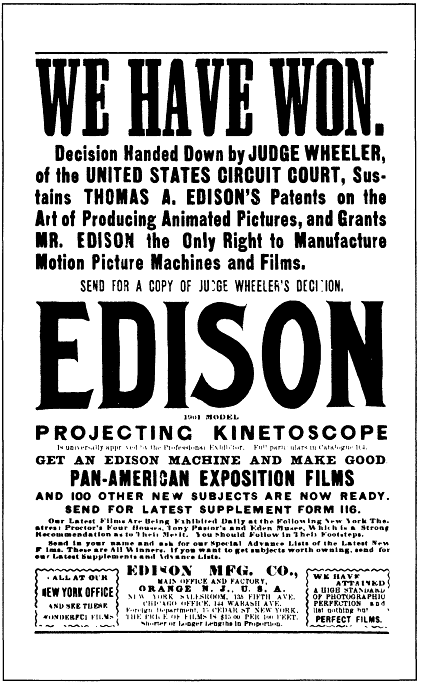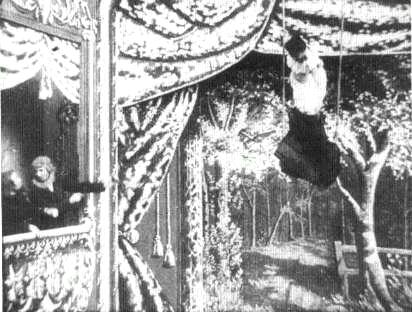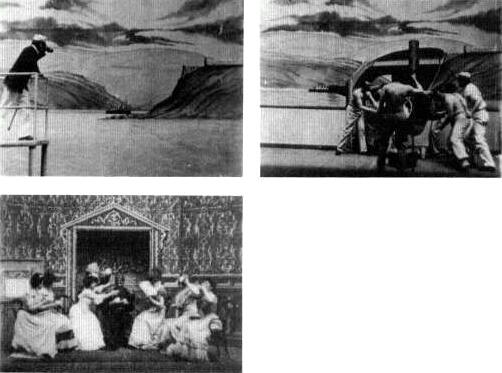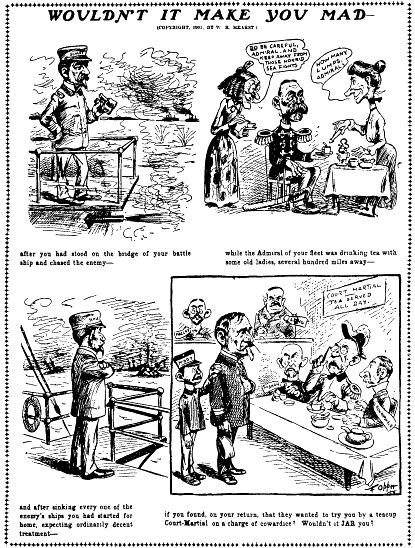Edison Attains a Virtual Monopoly
On July 15, 1901, a decision recognizing Edison's patent claims was handed down in the U.S. circuit court for the southern district of New York. Judge Hoyt Henry Wheeler's tentatively worded opinion concluded: "The defendant appears to have taken the substance of the invention covered by these claims and the plaintiff, therefore, appears to be entitled to a decree."[46] While the defendant, the American Mutoscope & Biograph Company, appealed to a higher court, it was allowed to continue operating under certain restrictions.[47] Yet even before Edison's victory, Biograph was struggling with financial adversity. That
New York Clipper, July 27, 1901, p. 480.
spring, the company had begun to lose money, a situation that continued well into 1902, if not beyond.[48] Its moving picture service was becoming less profitable and popular because the company was limited by its 70mm film format. Whereas exhibitors such as Vitagraph and George Spoor's Chicago-based Kinodrome Service could show European imports like Méliès' Cinderella on their 35mm projectors, Biograph could not do so. Biograph's logical move was to switch to a 35mm format, but its executives dared not do this, as their special-sized film could have provided a decisive distinction between the Edison and Biograph systems from a legal standpoint. The cost of litigation and the impact of Judge Wheeler's decision only furthered Biograph's decline.
Other "disruptive" elements within the industry were also affected by Judge Wheeler's decision. The Edison Company had hired Sigmund Lubin's chief photographer, Jacob (James) Blair Smith, starting July 14th. Smith, who assumed William Heise's old role, enjoyed a high weekly salary of $25 a week ($10 more than Porter's) because he could testify concerning Lubin's infringement on Edison's patents. As a result, after consulting with his lawyers, Lubin relocated to Germany.[49] With Lubin knocked out of competition, Vitagraph reduced to the role of exhibitor, and Biograph locked into a large-format film and on the commercial defensive, the Edison Company was on the verge of controlling the motion picture industry in America.
Edison's victory in the courts encouraged other holders of motion picture patents to negotiate a settlement. Thomas Armat, whose Armat Moving-Picture Company held important projection patents, was anxious to form a combination. To Thomas Edison, he argued that
Years have gone by and your proper profits in the business have not yet I believe materialized. The same is true of me. Every year cut off from my enjoyment of the fruits of my toil is a matter of loss. In looking over the field I am more and more convinced that the situation can be made to bear the full success of our hopes in but one way—by the formation of a trust into which you will throw your film patent, the Armat Company the Armat patents, and the American Mutoscope and Biograph Company its Mutoscope patents, together with a withdrawal of all further appeal on your film patent.
This combined action would establish a real monopoly, as no infringer would stand against a combination of all these strong elements. The way things are now the woods are full of small infringers who are reaping that which belongs to yourself and ourselves. . . . There is big money in all ends of this business if properly conducted and little in it otherwise.[50]
Armat's proposal revived earlier attempts at consolidation by Biograph and anticipated the combination of forces that eventually formed the basis for the Motion Picture Patents Company late in 1908. The trust Armat envisioned would, however, have centralized all activities within a single production office and hobbled the American industry for years. Although Armat and T. Cushing Daniel held meetings with Edison and Biograph, they could not agree on
the terms. Armat tended to view the projection patents as paramount, while Edison felt the same about his own position. The actual formation of a patents trust was to wait another six years until similar circumstances once again presented themselves.
When Edison's lawyer Howard W. Hayes learned of Edison's court victory, he sent Gilmore his congratulations from Europe and then asked:
Will it not be worth while to spend a little more money now in getting out a better class of films? I was surprised to find what good films they have here in Paris, they are very clear and with no jumps. Whenever any important even[t] happens like the Henley Boat Race, the films are on the market within two days afterwards.[51]
J. B. Smith, for one, helped to address some of these concerns. As foreman of the Edison film plant, Smith soon "made many improvements in the machinery and methods of taking and making pictures. At that time it required an hour to perforate 200 feet of film on a step punch which time has reduced to just one-third; it took 20 minutes to print the same length of film on what was known as continuous printers, which were succeeded by stop motion printers, which accomplished the same task in from six to seven minutes according to the density of the negative."[52] Smith, like Porter, was not only a cameraman but a mechanical expert.
The Edison Company continued active production in the wake of its court victory. Soubrette's Troubles on a Fifth Avenue Stage and What Happened on Twenty-Third Street, New York City appear to be ordinary street scenes at first, but each shows a woman unexpectedly revealing a significant portion of her undergarments. Both films featured A. C. Abadie as the swell and Florence Georgie as the unfortunate woman. In the latter picture, her dress is blown up when she steps over a Herald Square blow hole (anticipating Marilyn Monroe by fifty years).[53] Again, as Judith Mayne has pointed out, this is a film that appealed explicitly to male spectators.[54] Georgie's giggles reassure the spectator and authorize his look. Likewise the use of theatrical display and the performers' acknowledgment of the camera were perhaps necessary means of allaying the spectators' discomfort at an unexpected encounter with a forbidden, voyeuristic pleasure. Tom Gunning has called early cinema an exhibitionist cinema rather than a voyeuristic one as Christian Metz defines it. While this may be true, historically this rupturing of a self-enclosed fictional world usually mediated the spectators' experiences in ways that facilitated their voyeurism, not undermined it.[55] This is evident in Trapeze Disrobing Act , made that fall. The performer in this studio production was probably Charmion, whose "risque disrobing act on the flying trapeze" was popular at the turn of the century.[56] Although her striptease was performed for the camera and cine-viewers, the two male spectators inside the mise-en-scène authorized the film spectators' voyeurism. Such pictures were so "hot" that the Victorian males' repressive psychic mechanisms had to be allayed if these patrons were to find the intended pleasure rather than
Trapeze Disrobing Act.
unpleasure in their voyeurism. Produced for burlesque houses and "smokers," these films were by male filmmakers and for male spectators.
In contrast, one-shot comedies such as The Tramp's Miraculous Escape and The Photographer's Mishap were suited for "polite" vaudeville with its mixed-sex audiences. Both were photographed along train tracks, using stop-action techniques to simulate a train colliding with its victim.[57]Weary Willie and the Gardener and The Tramp and the Nursing Bottle , part of the tramp series, were shot in a park or in someone's backyard. Each recycled an earlier film gag. All of these comedies were made quickly and at minimal expense.
During their first six months, Porter and Fleming assumed editorial control only in highly circumscribed situations, chiefly by adding dependent tags as endings to one-shot comedies. Two films made in August and September 1901 suggest that they were moving beyond these constraints: Life Rescue at Long Branch and Sampson-Schley Controversy. Life Rescue at Long Branch , retitled Life Rescue at Atlantic City for the Edison catalog, presented a two-shot, staged rescue by lifeboat. It was a popular subject that Sigmund Lubin had filmed in Atlantic City during 1899. Lubin's Life Rescue was "the most wonderful picture ever taken. Two people went out too far in the ocean to bathe; the gentleman was drowned, the lady saved by the life guards, who can be seen swimming out to her."[58] The Edison film shows two different parts of a rescue, and connects
Sampson-Schley Controversy.
them with a dissolve. The major distinction between Life Rescue at Long Branch and earlier rescue films such as Ambulance Call and Ambulance at the Accident is the dissolve that ties the shots together and the corresponding assertion of editorial control by the cameraman/producer. It moved beyond the limitations of earlier Edison acted films as two shots of equal weight told a simple linear narrative. The film was more modest than James Williamson's Fire! made in England two months earlier, but it represented a minor advance in the Kinetograph Department's approach to filmmaking.
Sampson-Schley Controversy was based on an argument between two naval officers that had erupted onto the front pages of the popular press. The controversy concerned a naval battle in Santiago Bay during the Spanish-American War, the actions of the two principal American officers, and the question of who ultimately was in command. A political cartoon in Hearst's New York Journal provided Porter with a sketch for his film.[59] Since the cartoon reflected his own political sentiments, Porter probably found it an attractive subject to adapt.[60]
Sampson-Schley Controversy was first copyrighted as a two-shot film on August 15th and offered for sale. It was puffed in Edison advertisements as:
The greatest naval and dramatic Production ever attempted in animated pictures. Admiral Schley is depicted on the bridge of the "Brooklyn" commanding the American Fleet which is engaged with the Spanish fleet. A portion of Schley's crew appears in the immediate foreground of the picture furiously working a 13 inch gun and giving a dramatic demonstration of the famous picture "The Man Behind the Gun."[61]
The scene of Winfield Scott Schley on the bridge, which conforms to the first panel of the cartoon, is enhanced by the second shot, in which one member of the gun crew is killed. This illustrated a well-known incident of the battle in Santiago Bay, when Boatswain Ellis was killed and Schley insisted that his body remain on deck until it could be given a proper Christian burial.[62] Schley's conduct is associated with the actions of these courageous common sailors, while William T. Sampson was well known for his aristocratic pretensions.[63] Although mentioned in the title, Sampson was never shown in this version of the film. George Kleine thought that a more appropriate title would be Schley on the Bridge and Man Behind the Gun ; certainly it reflected the film's two-shot structure.[64] The sets were similar in both shots and used extreme theatrical foreshortening, with model boats in the far background representing the Spanish enemy.[65] The camera's framing of an identical background is slightly different in each shot, suggesting that the two scenes occur on different parts of the ship. The temporal relation between the two shots is vague, but potentially significant in light of Porter's later films: the relative positions of the model boats and the characters' behavior in each shot suggest a temporal repetition. It appears that these two aspects of the same battle occur simultaneously, but are shown successively on the screen.
Three weeks after its initial release, Porter added a final scene to Sampson-Schley Controversy . This was based on the second panel of the cartoon: "The conclusion of the picture shows Admiral Sampson at an afternoon Tea Party, the center of an admiring group of old maids. Length 200 ft."[66] A dissolve between the last two shots was achieved in the printing. The cartoon strip points out that Schley's actions on the Brooklyn occurred while the admiral was at a tea party. Contextual information thus indicates that all three shots of the Sampson-Schley Controversy represented actions occurring at the same time. The film raised the problem of depicting simultaneity, which Porter would confront again in later work. In the Sampson-Schley Controversy , however, this temporal simultaneity is only implicit. Audiences familiar with the cartoon or the controversy may have made the connection, or it may have been made for them by the showman. While temporal relations between shots were implied within the film itself, it was the exhibitor's or the spectator's task to define them more explicitly.
In expanding Sampson-Schley Controversy to three shots, Porter used his experience as a showman to produce a simple contrast: the man behind the gun/the man behind the tea cup. The use of contrast was an editorial strategy often employed by exhibitors. In an earlier Biograph program the operator showed a series of "couplets," including Blizzard in New York City/A Little Ray
A political cartoon in the New York Journal inspired Sampson-Schley Controversy.
Captions established the temporal relationship between scenes.
of Sunshine and Cremation/Hatching Chickens .[67] Similar combinations had also been suggested by slide producers for pre-cinema lantern shows. Clearly Porter had appropriated editorial responsibility formerly within the domain of the exhibitor to make a political comment. The acceptance of this new role was still limited: Kleine, for instance, was a Republican who may have sympathized with
Sampson and so chose not to sell the last scene-essentially registering an editorial veto. Although the film could still be used by showmen either within a variety format as a political editorial or as part of a larger program on the Spanish-American War (such programs continued to be popular), the tension between cameraman/producer and showman/exhibitor with regard to editorial responsibility had emerged as a central issue.



